Delaware Canal Towpath Reopened at the Lumberville Aqueduct Pedestrian Bridge
October 29, 2025
TOWPATH OPENED (Mile Post 31.11).
In the area of Lumberville, the towpath is REOPENED at the Lumberville Aqueduct Pedestrian Bridge.
TOWPATH OPENED (Mile Post 31.11).
In the area of Lumberville, the towpath is REOPENED at the Lumberville Aqueduct Pedestrian Bridge.
Life on the canal was not an easy one in the best weather. But what was it like in the winter? Several of our Friends asked the question. So, in the spirit of trying to be a source of information, useful and otherwise, we did a bit of research.
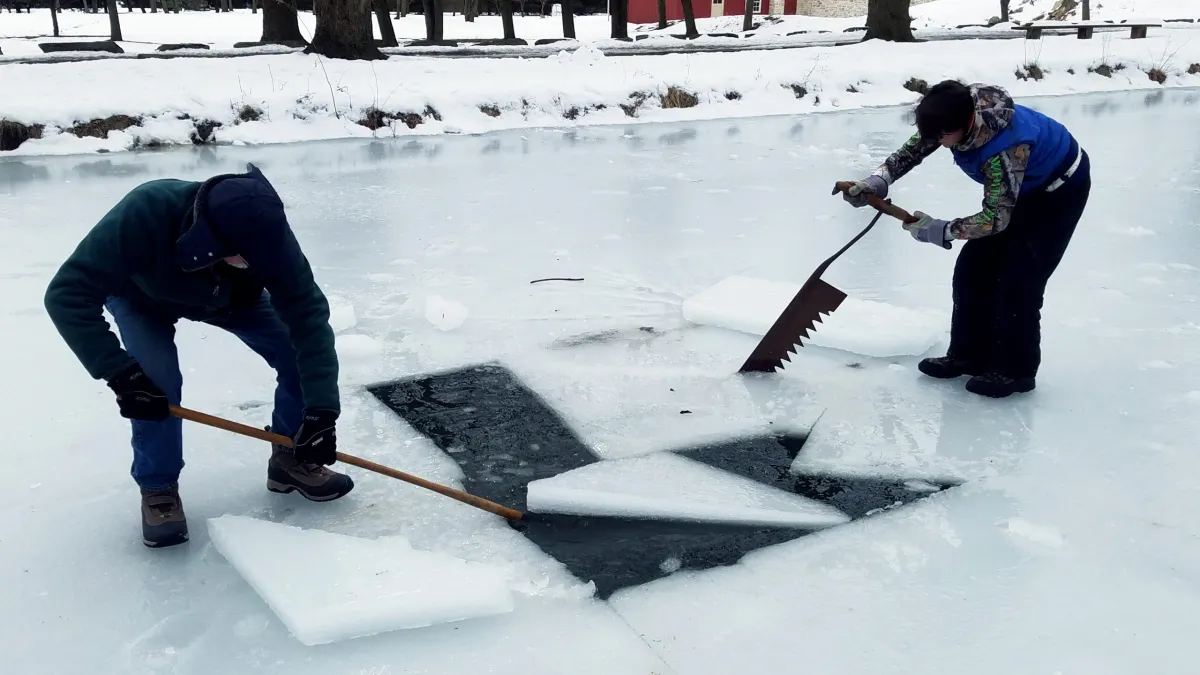 Most Canal boatmen and their families would take to solid ground in the winter. Many Canallers had established homesteads on land, or they would move to a nearly town or shanty. According to some oral histories, there were people, mostly young men, who might spend the colder months on the boat, but that was an exception, not the rule.
Most Canal boatmen and their families would take to solid ground in the winter. Many Canallers had established homesteads on land, or they would move to a nearly town or shanty. According to some oral histories, there were people, mostly young men, who might spend the colder months on the boat, but that was an exception, not the rule.
People who worked on the canal could not afford to remain idle all winter. Some men were employed to repair boats and other equipment in anticipation of a fresh start in spring. Others may have gone to the coal mines or worked cutting ice for refrigeration. Still others would work on repairing the canal itself.
In the winter, sections of the canal were drained. Boats that were not housed in a boatyard would be positioned in the middle of the canal. As the water level dropped, the canal boats would rest in the bottom of the canal prism where they would stay until spring.
The ice could damage boats that became frozen in place, so every effort was made to store them safely for the winter. Some accounts describe how ice breakers were drawn through the canal to release boats that were stuck. This task took a great deal of manpower as well as mule-power. In freezing temperatures, it was an arduous and dangerous process.
Today, a frozen canal no longer traps boats or provides ice. Instead, the canal in winter provides free fun for kids of all ages. Ice skating and hockey are two favorite pastimes. And you often see
cross-country skiers using the snowy towpath as they enjoy a relaxing and level glide.
So, be sure to take advantage of the Delaware Canal State Park in winter. Enjoy the serenity of the towpath covered in snow. Or, if skating is your passion, look for a solidly frozen spot to practice your figure-eights. And remember, always bring a friend or two.
See you on the towpath!
Bucks County is rich in history, and we can trace much of that history and growth to the impact of the Delaware River and Canal. River towns became hubs of industry, and when the Canal opened for operation, it spurred additional investment. Mills, lime kilns, farms, and other businesses flourished. When the Delaware Canal opened in 1832, it changed the river valley and the towns along the way. With improved transportation, commerce grew, and many people prospered.
As business people, travelers, and canallers flocked to the area, hotels and inns began to flourish. Many of the inns along the Delaware Canal were built around the same time. Others pre-date the Canal but certainly benefited from its operation. Trains and highways eventually replaced the Canal, however, many of the historic inns have remained, most for public use, while some are private homes. The number of Inns along the Delaware Canal makes this 58.9-mile waterway unique.
Starting in the north, we will take a walk back in time to revisit some of the inns and provisioners that have been around for centuries.
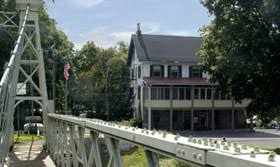 This Inn was built in 1838 by Benjamin Riegel, a wealthy miller who owned property on either side of the Delaware River. His New Jersey operations included a grist mill and an oil mill. John Riegel, the grandson of Benjamin, continued the industrial legacy of the family by adding a paper mill which became known as the Riegel Paper Company, one of the largest employers in the area until the 1990’s.
This Inn was built in 1838 by Benjamin Riegel, a wealthy miller who owned property on either side of the Delaware River. His New Jersey operations included a grist mill and an oil mill. John Riegel, the grandson of Benjamin, continued the industrial legacy of the family by adding a paper mill which became known as the Riegel Paper Company, one of the largest employers in the area until the 1990’s.
Riegelsville Inn is situated between the river and the Canal, next to the historic Roebling Bridge. It is listed on the Bucks County Register of Historic Places.
The original building is stucco over stone with porches facing the river and patio space on the Canal. At one point, the property also boasted a large barn with enough room for 50 horses (or mules).
Over the decades, the Inn has changed hands; however, it has remained in continuous operation for most of the past 160+ years. Today, the Inn offers fine dining throughout the week, with a brunch menu also available on the weekends.
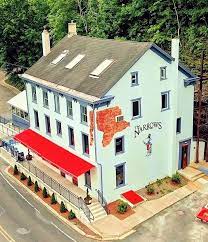 The Lenape Indian Tribe originally inhabited the site of the current Inn and restaurant. They used a deep natural pool in the rocks at the base of the Nockamixon Cliffs as a holding tank for fish they had caught in the Delaware River. When the current building was erected in 1820, owner Jacob Krouse used the rock walls of the tank as his new tavern’s foundation. The tavern license for the site dates back to 1812 when the pilots of lumber rafts were served a blicky (quart) of beer for a nickel.
The Lenape Indian Tribe originally inhabited the site of the current Inn and restaurant. They used a deep natural pool in the rocks at the base of the Nockamixon Cliffs as a holding tank for fish they had caught in the Delaware River. When the current building was erected in 1820, owner Jacob Krouse used the rock walls of the tank as his new tavern’s foundation. The tavern license for the site dates back to 1812 when the pilots of lumber rafts were served a blicky (quart) of beer for a nickel.
In 1837, new owner John Derr enlarged the business to accommodate weary travelers, and the Rising Sun Hotel came to be. It was known by that name until 1854, except for a short period in 1851 when owner Frederick Trauger thought it might do better as the Farmers and Traveler’s Inn. Apparently it didn’t, since the name and Trauger lasted less than a year. In 1854, owner Mathias Lehman changed it to the Narrowsville Hotel.
The Inn changed hands several times and was most recently called the Indian Rock Inn. This name derives from a nearby rock formation whose profile is said to resemble the face of an
Indian. The mural of an Indian life scene, painted in 1988 by Irish artist Eric Patton, decorated the north side of the building until the most recent renovation.
To the north of the Inn were mule stables, with a barn and blacksmith shop to the south.
Today, the Narrows Inn serves great food in alovely historic setting.
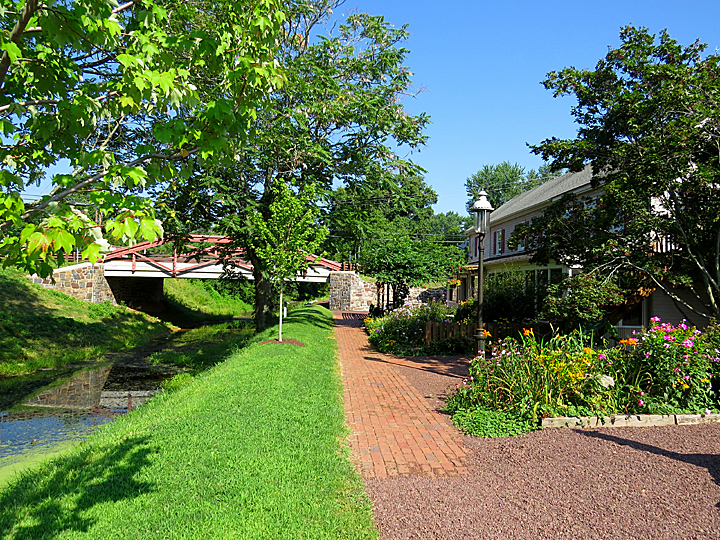 Another popular spot along the Canal is the Homestead General Store. This business has served the local community since the early 1800’s and is the oldest continuously operating general store in Bucks County providing provisions as well as a place to trade some canal gossip.
Another popular spot along the Canal is the Homestead General Store. This business has served the local community since the early 1800’s and is the oldest continuously operating general store in Bucks County providing provisions as well as a place to trade some canal gossip.
Originally built in 1831 by Hugh Major, the store arrived just in time to serve the newly opened canal and boatmen. Customers could stock up on provisions as well as local gossip. Today, the charm of the Homestead has been enhanced by the addition of a coffee roasting business. Their certified organic coffee is served and sold throughout Bucks and Hunterdon counties.
While the Homestead has seen several owners over the decades, Rick and Iris Lewis have been the proprietors since 1980. They have witnessed floods, bridge closures, and other calamities but have endured throughout it all. The Homestead has earned a reputation for its food and family-friendly atmosphere. It is a great place to stop along your towpath stroll.
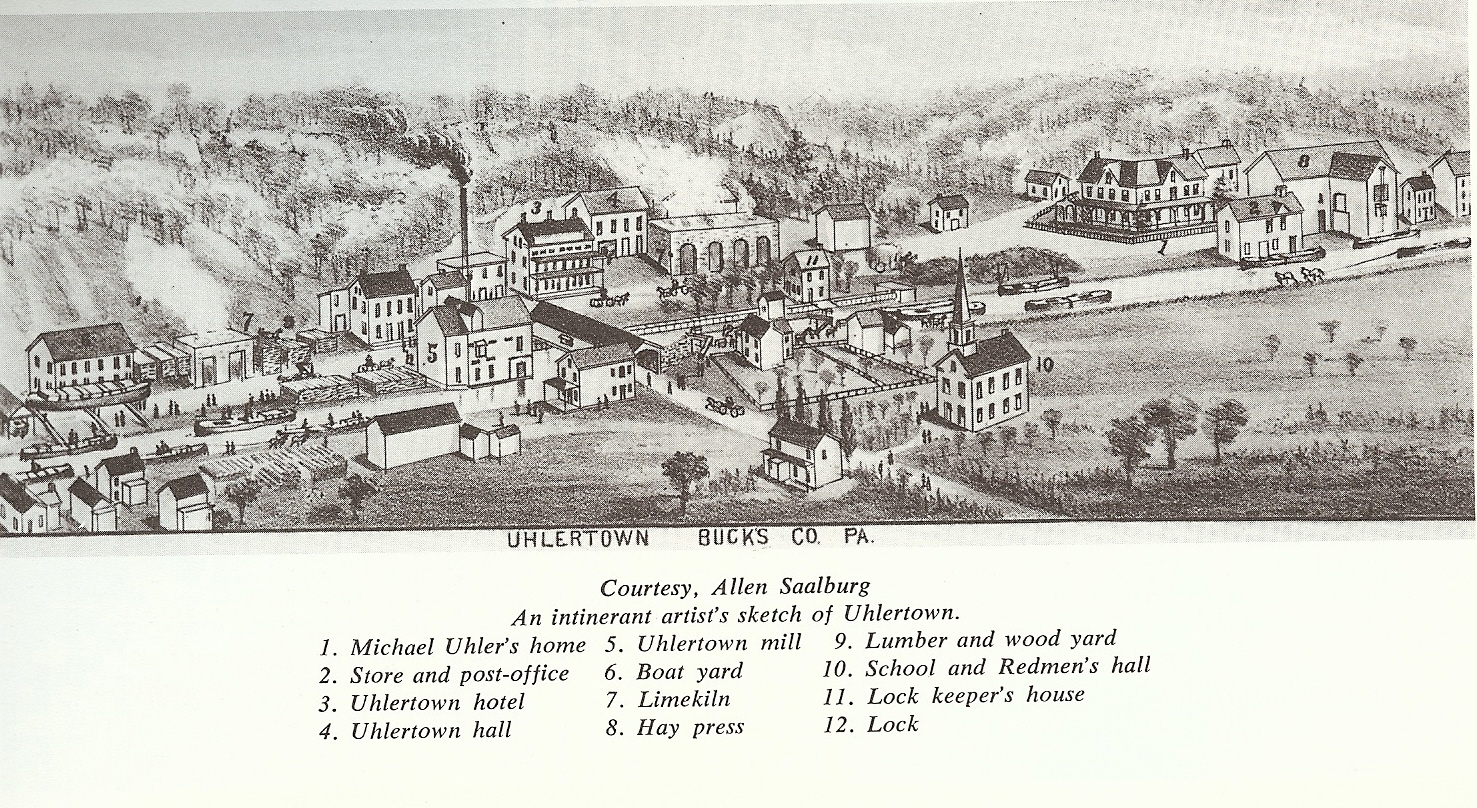 Now a private residence, the Uhlerstown Hotel was once a favorite resting spot for weary travelers. Built around 1840, the hotel was added to the National Register of Historic Places in 1994. Today, the entire hamlet is listed as a historic district.
Now a private residence, the Uhlerstown Hotel was once a favorite resting spot for weary travelers. Built around 1840, the hotel was added to the National Register of Historic Places in 1994. Today, the entire hamlet is listed as a historic district.
The natural charm of the hotel is enhanced by its location in this well-preserved little hamlet. Uhlerstown is one of the true historic gems along the towpath. This village was once a prosperous
settlement, built mainly around the Canal and its operations. Michael Uhler, a man of remarkable energy and business ability, recognized the opportunity that the Canal offered and moved downriver from the Groundhog Lock area between Riegelsville and Raubsville, where he and his brother Peter had been doing business.
Uhler developed the town that would be named after him. He is best known for operating a boat building yard and running a line of wellequipped canal boats called the Michael Uhler line. He owned extensive farmland from which grain and hay were supplied to the canal trade and metropolitan markets. He built and operated a gristmill and lime kilns, a country store and post office, a saddler shop, and coal yards. The hamlet is also home to the only covered bridge that spans the Canal.
Today, the historic district encompasses 63 contributing structures located along the Delaware Canal. Buildings of note include a brick building that once housed a school. The building to the right of the bridge entrance was the residence of Jonas Sigafoos who operated a general store. To the left of the bridge entrance, the present home was originally a warehouse for the gristmill located on the opposite bank of the Canal. Other historic buildings include the Uhlerstown Hall, a community gathering place for dances and entertainment, the Locktender’s House, and the remnants of lime kilns.
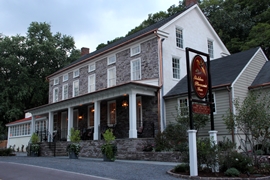 Originally called the Delaware House, the Golden Pheasant Inn was built in 1857 to cater to the canal trade. The Inn offered housing for men and mules along with provisions. When the Canal closed in 1931, the Inn suffered hard times until 1967, when it was purchased by Ralph Schneider, who named it the Golden Pheasant Inn.
Originally called the Delaware House, the Golden Pheasant Inn was built in 1857 to cater to the canal trade. The Inn offered housing for men and mules along with provisions. When the Canal closed in 1931, the Inn suffered hard times until 1967, when it was purchased by Ralph Schneider, who named it the Golden Pheasant Inn.
The Inn is situated on the eastern boundary of Tinicum township in a section of Bucks County which was called Manor of Highlands. In 1699, the 7,500 acres were purchased from William Penn
by the London Company.
In 1986, the Faure family purchased the property. Michel Faure was the chef, and his wife Barbara was the hostess and decorator. Barbara refurbished the rooms to the Inn’s original 1850s period
style. Within three months of opening, John Bull, a restaurant critic for the Philadelphia Inquirer, gave the new Inn a resounding “thumbs-up.”
The Faure’s daughters, Brittany, Blake, and Briar assumed the business and operated the Inn and restaurant for many years before selling it to the Thompson Hospitality organization.
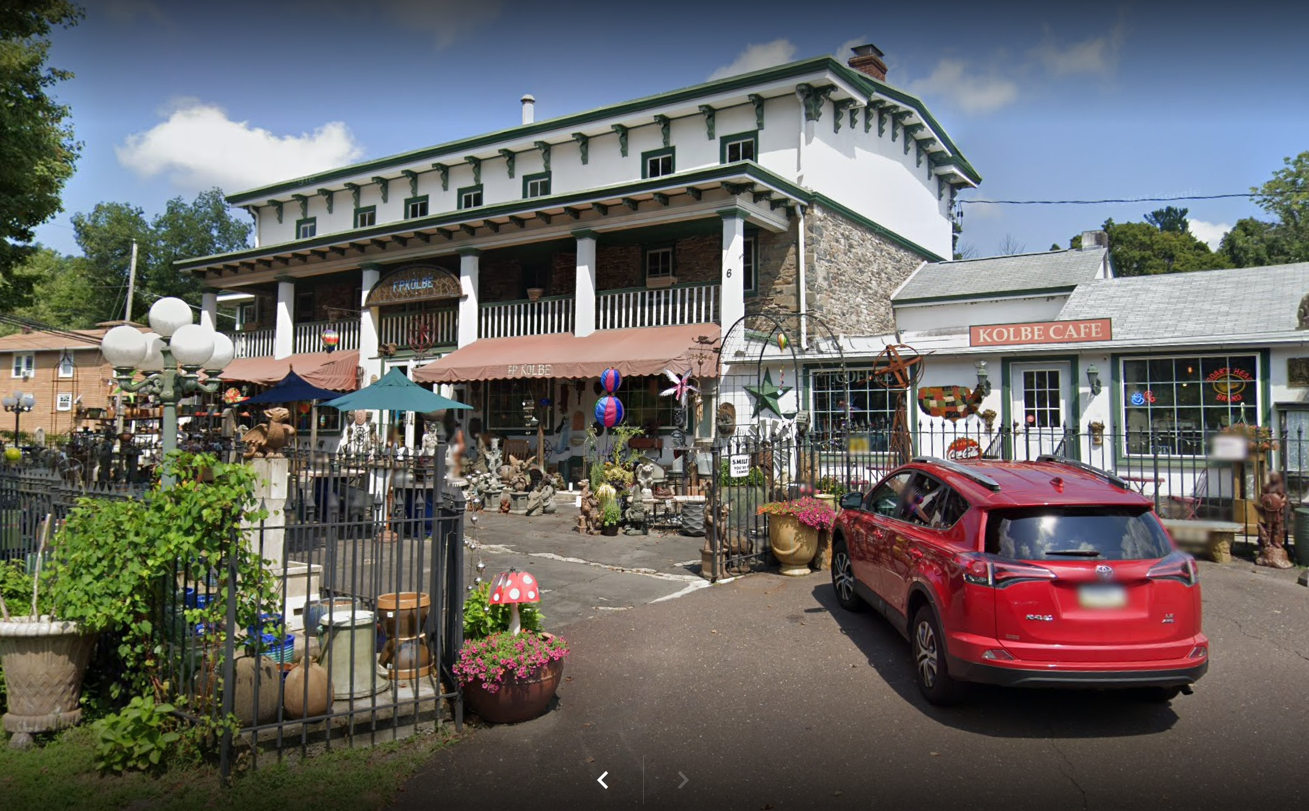 At one time, Point Pleasant was a bustling commercial center largely catering to the canal and carriage trade and then to vacationers who discovered the charms of this river valley town.
At one time, Point Pleasant was a bustling commercial center largely catering to the canal and carriage trade and then to vacationers who discovered the charms of this river valley town.
The Point Pleasant Inn (above, right), as it was initially known, was built in 1782. This grand hotel hosted Grover Cleveland, William McKinley, and other fishing enthusiasts. Prominent Astor, Whitney, and Vanderbilt family members were also guests. The elegant colonnaded façade faces out over what was once a lovely view of the Tohickon Creek.
Today, the building is home to F.P. Kolbe Gift Store & Café. It is a favorite shopping spot for seasonal decorative items, candles, garden fountains, and hand-crafted furniture.
Standing by the picturesque waterfall above the Cuttalossa Inn, it is hard to imagine that this was once the bustling center of the village of Lumberton. Approximately 200 people lived here, including Zebulon Pike (of Pike’s Peak fame) operating the quarries and several mills.
The Cuttalossa Inn was a general store and post office; the stone building across from it was “Hard Times Tavern” as the proprietor made barely enough to pay the rent.
The quarries above and below Cuttalossa Road produced stone used in mansions in Philadelphia and New York City. Canal barges transported it to Philadelphia and by railroad (Jersey side) to New York City. A cable car from the towpath across the river delivered the stone to the railroad.
A sawmill was located above the falls, powered by a 20-foot diameter water wheel; the mill race can be discerned on the left as one moves up Cuttalossa Road. Immediately below the falls, at the parking area level, was a decking from one bank to the other, called a forebay—a place to stack the milled lumber in an otherwise tight valley. This picturesque spot has been a favorite subject of painters and poets alike.
There are other notable historic inns, including the Black Bass Inn located in Lumberville. The Black Bass was built in 1740-1745, was partially destroyed by fire. There was substantial rebuilding in 1834. The original owner of the establishment was a Tory who favored the British, so George Washington did not sleep here. However, today all are welcome to eat or stay here.
The Washington Crossing Inn was built in 1817 and it features an original large kitchen hearth in one of its dining rooms. The Yardley Inn, once called the White Swan Inn was built in 1832.
And in Bristol, you will find one of George and Martha’s favorite spots, The King George II Inn (right). This Inn has a rich history, and is the oldest, if not one of the oldest, operating inns in the
country. Established in 1681, the property is lovingly maintained by the current owners who are committed to providing great food and service in a truly unique setting.
One last Inn we feel we should mention, was located in the village of Raubsville, north of Riegelsville and close to the Forks of the Delaware River. The building still stands today, but remains empty.
No matter where you start your hiking or biking excursion along the towpath, you are sure to pass one of these historic inns and businesses. We encourage you to take advantage of the views,
the food and the hospitality each has to offer.
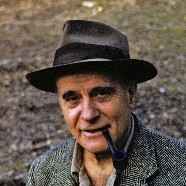 Something new is brewing at Lock 11 in New Hope. A new exhibition commemorating the140th Birth Anniversary of William Francis Taylor will open in the old concession building next to the Locktender’s House at 145 South Main Street New Hope. The exhibit will provide a chronology of the life and times of Taylor and his contribution to preserving the Delaware Canal and Towpath.
Something new is brewing at Lock 11 in New Hope. A new exhibition commemorating the140th Birth Anniversary of William Francis Taylor will open in the old concession building next to the Locktender’s House at 145 South Main Street New Hope. The exhibit will provide a chronology of the life and times of Taylor and his contribution to preserving the Delaware Canal and Towpath.
Who was William Francis Taylor?
Before the Friends of the Delaware Canal came into being, there was the Delaware Valley Protective Association, and William Francis Taylor was its first president. Formed in 1933, the DVPA encouraged the state to restore and maintain the Canal. Later, the organization was also responsible for securing an essential historic national landmark designation, protecting the Canal and towpath for generations to come.
In 1939, Taylor launched a magazine titled Towpath Magazine, a monthly publication focused on preserving “the beauty and value of the valley.” He wrote numerous articles focused on nature and the environment. Notably, the significant beauty of the Delaware River Valley landscape and that of the canals—both the Delaware Canal and the Delaware and Raritan Canal—were frequent subject matter in his writing and his artwork, calling attention to the importance of their preservation.
An Artist of Distinction
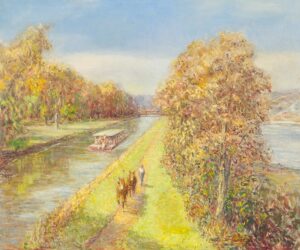
As an artist, William F. Taylor was considered part of the New Hope Impressionist School. Taylor was a student of William Lathrop and became well known for his landscapes and depiction of Washington Crossing the Delaware. His works can be found at the Corcoran Gallery and the Metropolitan Museum of Art.
William F. Taylor was born in Hamilton, Ontario, Canada, where he started his art career as a lithographer and illustrator. In 1905 he moved to New York and studied with John Sloan at the Art Students League. Taylor had swiftly excelled in the illustration field and was appointed art director of the New York Journal in 1908. He held this position for several years while also working as a freelance artist and illustrator for national publications such as Harpers and Century magazines. For many years, Taylor worked for the A.G. Spalding Sporting Goods Company, creating the original art for most of their advertisements. Around 1910, while visiting Phillips Mill, Taylor met fellow artist Mary Smith Perkins, who was studying with his friend William Lathrop. A relationship developed, and in 1913, they married and moved to Lumberville, Pennsylvania. In that same year, Taylor became a naturalized citizen.
Living on the Delaware River, a stone’s throw away from the home of Daniel Garber, Taylor was surrounded by a wealth of subjects for his art. His paintings possess a distinct and appealing style, employing a bright, fresh palette using both a palette knife and brush to apply his paints. Painting the majority of his work within several miles of his home, Taylor also painted on Long Island in New York, and out west in the Yosemite Valley. However, he felt his strength as a painter was his ability to capture the beauty of Bucks County.
Taylor was a member of the Salmagundi Club, the Phillips Mill Community Association, the New Hope Artists and Writers Association, the Delaware Valley Protective Association, and the Asbury Park Society of Fine Art.
He exhibited at the Province of Ontario (1902 medal), the National Academy of Design, the Society of Independent Artists (1917), the Salmagundi Club (1924, 1927, and 1932 prizes), the Philadelphia Art Club (1924 prize), the Philadelphia Art Alliance (Purchase Prize), and the Phillips Mill.
A Persistent Preservationist
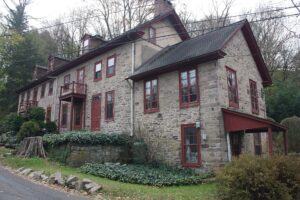
William F. Taylor is remembered today not only for his fine impressionist landscape paintings but also for his organizing and writing abilities. In October 1928, he was appointed to head a subscription committee that would ultimately be responsible for purchasing the Phillips Mill for use as an exhibition space and community center. In 1963, he published a history of the mill. Additionally, he published several articles on local artists. Taylor remained active until his death at age eighty-seven.
Taylor’s love of history and preservation was also evident in his purchase and restoration of the Cuttalossa Inn. He acquired the 180-year-old building in 1930. He also owned, lived in, and rented rooms at the Hard Times Tavern.
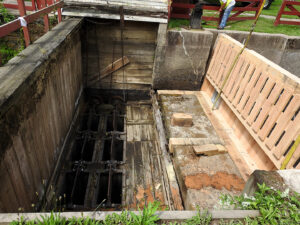
Construction of the Delaware Division of the Pennsylvania Canal system began in 1827 and was completed by 1832. The quick work created a less than water-worthy structure and the canal quickly required additional funding and manpower to keep the boats afloat.
However leaky the original design, it included many features and mechanisms that can still be seen today. In fact, some are still in use.
From Bristol, the Delaware Canal rises 165 feet above sea level in Easton. This elevation change was overcome using 23 lift locks. Other structures along the canal included: 10 aqueducts, 21 waste gates, 8 stop gates, 27 overflows, 125 bridges, 1 weigh lock at Easton, 1 outlet lock and 1 tide lock. With careful restoration, preservation and maintenance locks, waste gates, and bridges add to the historic value of this natural resource.
The canal structure itself is called the prism. Its name comes from the shape, being narrower on the bottom and wider on top, creating a “prism.” The bed of the canal was generally lined with clay, but in the haste of construction, other more porous materials were put to use.
Waste gates and stop gates may sound similar but they serve two different functions. Waste gates are used to lower the water level in the canal (eliminating extra or “waste” water). Stop gates are used to divert water back into the river, protecting the canal downstream from flooding. During times of torrential rains, these gates are vital to preserving not only the canal structure but neighboring property as well.
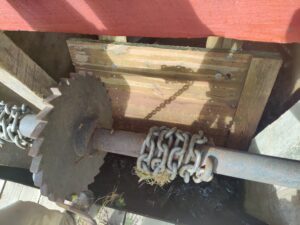
Overflows or spillways are also used to control the level of the canal. During the recent rainstorms and Ida, these spillways became so inundated with water, that pedestrians could not pass for fear of being swept away. On a normal day, bikers, hikers and walkers alike may get a bit wet but they can easily cross these concreate structures.
By far, the most complex mechanism along the canal is the lift lock. Locks are essentially elevators for canal boats. These enclosures were either filled with water or emptied, depending on whether the canal boat was traveling upstream (higher elevation) or downstream (lower elevation.) The lock chamber consisted of a floor, two walls and lock gates at either end. It was filled or emptied using openings in the lock gates, called wickets. (cont’d next page)
Steps to locking in when going downstream:
1. If the lock is empty, the lower miter gates are closed. The lock is then filled with water by opening the wickets (rotating valves) in the bottom section of the upper gates.
2. When the lock is full, the upper miter gates are opened, and the canal boat enters.
3. The wickets in the upper gates are shut, and the upper miter gates are fully closed.
4. The wickets in the lower gate are opened, and the level of the water in the lock is dropped until it is the same as the water level below the lock, lowering the boat.
5. When the water levels match, the lower miter gates are opened and the canal boat is pulled out of the lock and continues on its southward journey.
Lift locks have been in use for centuries in China as well as the Netherlands and Belgium. Variations of the standard lock can be found in the Theodore Roosevelt Recreation area, where two locks, Locks 22 and 23, were combined into one. At the beginning of the canal in the north, is a Weigh Lock in Easton. At the southernmost point along the canal is a Tidal Lock in Bristol.
Aqueducts are another important feature of the Delaware Canal. There are 10 aqueducts along the length of the waterway. Recent storm damage caused two of these structures to weaken or collapse entirely. Replacements and repairs are being planned for the aqueducts in Point Pleasant and Lumberville. When still in use as a transportation corridor, the aqueducts on the canal transversed streams carrying not only water but the boats as well. In later years, when commercial use stopped, these structures became a favorite watering hole of local bathers.
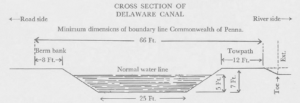
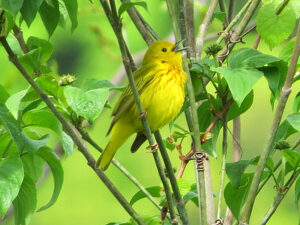
Zoom meetings, webinars, a YouTube channel. The Friends have been changing their storytelling game since March 2020 when we held our last in-person public program. Please
visit the Friends of the Delaware Canal YouTube channel to find the Canal Times I and II programs and a video interview with Will Rivinus, who tells about his first venture into canal walking. Unfortunately, our two Postcards from the Past presentations aren’t there because the Zoom recordings cut off after 30 seconds in spite of our best efforts.
The dates and times of the future webinars will be sent via Constant Contact. If you aren’t signed up, just scroll down to the form on the homepage of fodc.org or call 215-862-2021. The information will also be posted in the Events section on the homepage of fodc.org.
There are still lots of stories to share, and videos will be part of the mix. Want to help? The Friends could really use someone who is relatively experienced and enthusiastic about making “informal” videos. Interested? Please let us know.
See you one way or another!
JOIN US FOR THESE UPCOMING WEBINARS:
******************************************************************************
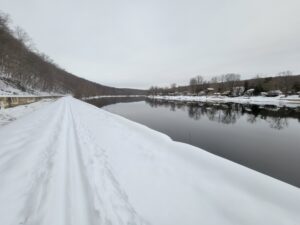
The snow just kept falling this past winter making the Delaware Canal an extraordinarily beautiful white wonder. By all reports, it was the best winter for cross-country skiing on the towpath in at least ten years.
Unfortunately, the season’s weather also created some serious problems along the Canal. Torrential rainfall at Christmas caused inland streams to overtop their banks and the Delaware River to rise to Minor Flood stage.
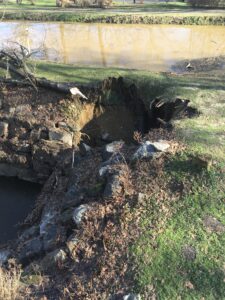
The relentless flow of stream water into the sub-canal culvert just north of Locks 22-23 in Raubsville caused its stone headwall to collapse. With the falling stone came a portion of the Canal berm bank, bringing the situation perilously close to completely blowing out the bank and seriously flooding the inland residential property. Thankfully, the erosion stopped short of that. The collapse was designated as an “emergency repair” by the DCNR engineers and Park staff, and Bi-State Construction was on site within days of December 26 to clear the culvert opening so that stream water could flow through it and to begin the repair of the culvert itself. Good progress was made, but then the snow and ice came making it too dangerous for the equipment to maneuver at the site, which is both narrow and steep. The project has resumed and is expected to be complete within weeks.
The flooding Delaware River rose to levels where its water overtopped the banks of the Canal in low areas. The flood waters caused damage to the towpath surface in several sections, particularly in the northern end of the Canal, and, just south of Easton, the earth sloughed off the slope of the towpath bank.
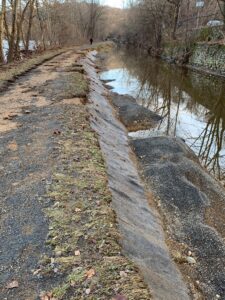
The high and rushing water in the Canal itself caused problems. The interior decking in the new Fry’s Run Aqueduct experienced some displacement, which can be repaired by the Park staff. More complicated will be the task of removing some rocks that lodged themselves between the layers of the synthetic liner at the Tinicum Aqueduct.
In the case of all these problems, as well as projects that were underway last fall, the snowy conditions prevented work from progressing, but spring is on its way, and with it will come the renewal of repair work.
******************************************************************************
By Devin Buzard
One of my favorite idioms is “Make hay while the sun shines.” Over the past year, while in service to the Delaware Canal, I have found this expression to be meaningful on multiple levels. I would go as far as to say that it encapsulates the general concept of confronting the challenges of Canal maintenance and management. There is never a shortage of work to be done and always an appropriate time to do it.
Repair projects along the Canal have recommenced with the melting of the snow. The large excavators, currently located in Raubsville, once again have come back to life. The removal of a sycamore tree with a destructive root system kickstarted our extensive efforts to reline the Canal and restore its ability to retain water.
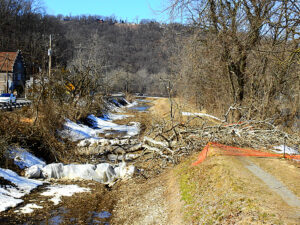
Over these past snowy months, I am happy to report great success in filling several vacant full-time Canal positions in our Southern offices. These include a Park Maintenance Supervisor and a Maintenance Repairman (skilled tradesman), who was recently added to our staff complement. Newly hired Park Maintenance Supervisor Matthew Overbeck of Pipersville replaces Brad King, who retired after his 35 years of service to the Commonwealth.
On the heels of former Delaware Canal Assistant Manager Bethany Hare taking a promotional opportunity, we are just weeks away from announcing the hiring of two new Assistant Managers. This is all good news as we are looking to the future of the Canal with a dedicated administrative presence and offices in both the Northern and the Southern sections. The concept is similar in nature to how our maintenance responsibilities are currently established. This is all taking place in conjunction with the recent acquisition of the former David Library of the American Revolution and the Sol and Rose Preserve properties in Washington Crossing.
As you may already know or gleaned from this newsletter, the Canal sustained significant damage during the December heavy rains and river flooding event. While timelines for all of the repairs to be completed are still unknown due to the severity of the damages, I am certain that the appropriate resources are being committed, and we are pushing towards the goal of opening the Easton feeder gate as soon as possible.
While on the surface it would appear that work is weather dependent, I would argue that work is perpetually progressing forward and with your support we will “continue to make hay”.
******************************************************************************
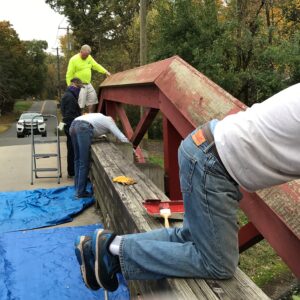
Before winter set in, seven Canal Action Team members gave the Mt. Eyre Road Bridge over the Canal two much-needed coats of barn-red stain. The bridge, located on the line between Lower Makefield and Upper Makefield Townships, is one of, if not the only, public road bridge over the Canal owned by the PA Department of Conservation and Natural Resources.
Under the direction of Team leader Bob Ketler, the CAT members came laden with their most trusty painting tools and went to work—bending, stretching, leaning, and crawling to reach all the components of the two faux camelback trusses.
After a full morning’s worth of work with Delaware Canal State Park Rangers handling traffic control, CAT brought the Mt. Eyre Road Bridge back to an appearance worthy of a Canal landmark.
******************************************************************************
The Friends are planning to bring back our series of “Green Phase” COVID-precautioned short walks as soon as the Pennsylvania Department of Conservation and Natural Resources (DCNR) allows public programs to resume. To account for the uncertainty of conditions and time frames, these walks will again be Pop-Ups, but we are scheduling a Spring Beauties Walk on Sunday, April 18, just to try to get things back to being a little more normal.
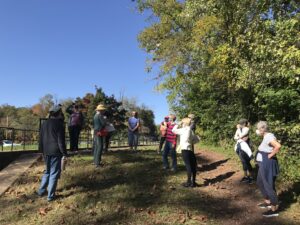 POP-UP SHORT WALKS
POP-UP SHORT WALKS
Locations, Dates, and Times are sent via
Constant Contact and posted on fodc.org.
We were able to get 11 short walks in last season and have another 20 walk itineraries ready to go as opportunities arise. The walk lengths vary from 2 to 6 miles roundtrip. In addition to late afternoon ventures, we anticipate that weekend and morning walks can be added to the schedule.
To walk with the Friends, watch for our Constant Contact e-mails and check Events on the homepage of fodc.org. If you are not on our Constant Contact list, please scroll down to the bottom of the homepage to sign up or call 215-862-2021.
To discourage the spread of COVID, these walks will once again be limited to 10 people, masks must be worn, and physical distancing encouraged. Reservations must be made in advance. All information will be included in our event notices.
These walks fill up very quickly, so when you receive the notices, don’t hesitate to make your reservations. To be fair, preference will be given to those who have not participated in other short walks during the current season.
******************************************************************************
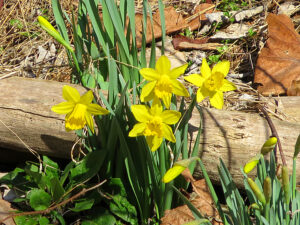
SPRING BEAUTIES WALK
SUNDAY, APRIL 18, 1:30 PM
Meet at the I-295 Park and Ride Lot
1140 Woodside Road, Yardley, PA 19067
Beauty comes in different forms. On this 2-mileroundtrip walk, you can take in the Canal’s beauty at Lock 7. Daffodils dance on the towpath bank and trees will be blossoming. The Lock with its stone walls restored by the Friends, the little board and batten shanty, and the Locktender’s House complete the spring scene.
Another kind of beauty shows itself at the 1799 House sitting by the Canal at Woodside Road. This historic stone house was purchased by the Delaware River Joint Toll Bridge Commission as part of the Scudder Falls Bridge project. The house has been sensitively rehabilitated and serves as a restroom facility for Canal visitors. Having a new bathroom facility near the Park, in a saved historic structure, no less, is a beautiful thing.
The Spring Beauty Walk will be led by veteran Canal Walker Jeff Connell, who also serves on the Friends’ Board of Directors. He will share the story of the Scudder Falls Bridge pedestrian pathway, which will be the seventh river bridge crossing connecting the Delaware Canal towpath to the D&R Canal towpath in Ewing, NJ. Along the way to Lock 7, he will point out the newly replaced 9-11 memorial bench and a wildlife haven.
Applicable COVID precautions, as described in Pop-Ups, will be taken. Reservations are required no later than April 14. Please call 215-862-2021 or e-mail friends@fodc.org.
Hope to see you on the towpath!
*******************************
CANAL CLEAN-UP DAY
SATURDAY, APRIL 10
PLUS
Any Day, especially during the month of April
Usually, the Friends’ annual Clean-Up Day takes place on the first Saturday in April, and hundreds of volunteers tackle the trash that has accumulated in and along the Canal’s 58.9-mile length. Of COVID Times necessity, this year’s clean-up will focus on individual and family group efforts—no large groups will be encouraged. The official date is also different because the first Saturday in April is the opening day of trout season in Pennsylvania and occurs during the Easter holiday weekend. To compensate for these unusual circumstances, we are extending Clean-Up Day and encouraging volunteers to give the Canal its spring cleaning anytime, particularly during the month of April.
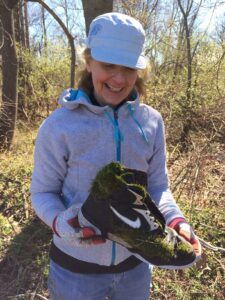
Here’s how to help this spring –
On Saturday, April 10, go out to any section of the Canal and pick up trash, debris, and anything that doesn’t allow the Canal to look its best. Both on-land and by-boat clean-ups are welcome. In fact, using canoes and kayaks is sometimes the only way to get to trash on the berm side or just hiding below the water surface.
If you can’t be out on the 10th, please work anytime the weather and your energy encourage you to do so.
For the safety of all, volunteers must comply with federal CDC, State, and local COVID-19 precautions, including, but not limited to, wearing a face mask, practicing physical distancing, and following proper hygiene protocols. (Handwashing is and always has been a good idea on Clean-Up Day.)
Please wear gloves and sturdy shoes and bring along any pick-up tools that work well for you.
If you need trash bags or gloves, we can supply them. Contactless pick-up can be done at either the Locktender’s House in New Hope (call 215-862- 2021 or e-mail friends@fodc.org) or at the State Park Headquarters in Upper Black Eddy (call 610-982-5560 or e-mail kmartens@pa.gov).
If you collect things that are too heavy or unwieldy to take home for disposal, please let the Friends know the location, and the Park staff will make pick-up arrangements.
And don’t forget to let the Friends know that you’ve been out there working, so that we can thank you as well as count the number of volunteers who participated and determine what areas might need attention after April. Please take pictures and share them!
The Friends have done clean-ups ever since the organization’s founding in 1982, and we intend to keep up that tradition because our goal is always to be of help to the Delaware Canal.
If you have questions about these new circumstances, please call 215-862-2021 or e-mail friends@fodc.org. And THANK YOU for your concern and help!
To all of you who invested in the Friends’ efforts by contributing to our Year-End Appeal, THANK YOU! After nine months when the Delaware Canal provided much-needed refuge, serenity, and recreation, it was clear that you wanted to help the Friends improve and maintain the place that had given you so much. Many people who contributed at year-end had never done so before.
YOUR GENEROSITY HAS EASED THE WAY INTO WHAT WE HOPE WILL BE A YEAR OF SIGNIFICANT PROGRESS.
Can the sixth and final historic camelback bridge over the Canal be restored in time for the Friends of the Delaware Canal’s 40th anniversary in 2022?
Yes, we feel confident that it can be—with your help. Out of the 100+ bridges that once crossed the Delaware Canal, Spahr’s Bridge in Upper Black Eddy is one of only six that retains its authentic and iconic camelback structure. The Friends spearheaded the restoration of four of the other camelbacks, encouraged the fifth, and have had Spahr’s on our to-do list for years.
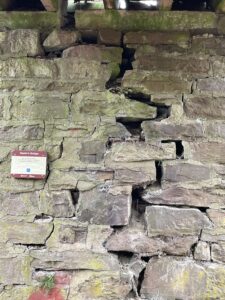
Spahr’s Bridge has been a formidable project to tackle because not only is the superstructure severely deteriorated, but also both stone abutments are cracked, a condition exacerbated by two earthquakes. The $350,000-$400,000 cost of restoring Spahr’s Bridge has been an obstacle.
Now the stars are aligning. The relatively new owner of the property on either side of the Bridge believes in historic preservation and supports its restoration rather than modernization. The condition of Bridge is now so poor that action by the State is inevitable. The Friends have been very vocal in our support of handling the project using historic preservation best practices, and the State agrees. Plans are now underway to hire a highly qualified contractor to dismantle the superstructure taking care to inventory and record the existing members and store and reuse timber and hardware when possible. The State plans to contract with a consultant to prepare the plans and specifications for the repair of the stone abutments. The State will fund both the dismantling and the abutment projects.
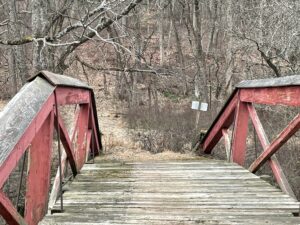
And we come to the part of the Spahr’s Bridge project with which you can help. Private contributions are being sought to fund the superstructure portion. In simpler terms, the trusses, the deck, the cross beams, and the hardware. Putting Spahr’s Bridge together requires expertise, skills, and passion. The Friends contribution to the project will help ensure that those requirements are met. We are very pleased and thankful for two very generous donations from the Goodfellow Fund and Barbara and Peter Sperry. They have given the Spahr’s Bridge restoration a great jump start.
More information about how you can help will be coming soon. If you’re already convinced, you can donate now by scrolling down on the www.fodc.org homepage to the Spahr’s Bridge contribution block or, even better, send your check to Friends of the Delaware Canal, 145 South Main Street, New Hope, PA 18938.
******************************************************************************
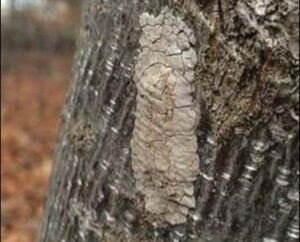
As we learned last year, getting rid of Spotted Lanternflies while they are alive is a challenge. They jump; they fly; they jump; they fly…
There is still time to control these destructive insects before they hatch and fly off on their pretty wings. Start finding and destroying their egg masses now. Spotted Lanternflies lay their eggs in the fall, usually on flat surfaces like tree trunks, rocks, walls, wood fencing, even outdoor equipment.
It may take a bit of investigating, but you will become better at tracking them down once you know what to look for. If you have an Ailanthus tree aka Tree of Heaven on your property, check there first. These trees are a Lanternfly favorite. If you noticed an infestation on your property, be sure to scan that area as well.
You can remove their mud-like egg masses with a paring knife or a small plastic card, like a credit card. Using a rigid surface, you can crush the eggs or, even better, remove and destroy the entire casing by scraping it into a plastic bag containing rubbing alcohol. Once the eggs come in contact with the liquid, they will die. Killing eggs now will help curb this pest this summer.
So, harness your pent-up pandemic energy and go Lanternfly hunting.
******************************************************************************
The Delaware Canal State Park has experienced a historic increase in visitation since last March when the consequences of the COVID-19 pandemic set in. We’re pleased to say that the many people didn’t cause a dramatic increase in the amount of trash left behind, thanks to the care taken by visitors and the diligence of the sixty volunteers who serve in the Friends’ Canal Tenders program.
Many, many thanks to all the Tenders, who pick up trash, clear branches, and report problems throughout the year. Their pandemic precautioned clean-up efforts make the Canal a better place for both people and critters.
We are pleased to welcome two new Canal Tenders to the crew!
David Weiss has volunteered to co-tend the Canal from Black Rock Road to East Afton Avenue in Yardley along with veterans Ann and Keith Webb.
A. J. Zolton has taken on the section from Lock 17 (Treasure Island Lock) in Tinicum Township to Lock 18 in Uhlerstown.
Several sections in the southern end of the Canal remain without Tenders including:
• Riverfront Park to Beaver Street: Bristol Borough
• Beaver Street to the Bristol Lagoon at Jefferson Avenue: Bristol Borough
• The Bristol Lagoon to Green Lane: Bristol Borough
• Green Lane to Edgely Avenue: Bristol Township
• Edgely Avenue to Levittown Shopping Center: Bristol Township/Tullytown Borough
• Wheatsheaf Road to the Conrail Tunnel: Falls Township
Please let us know if you can help with any of these sections. The boundaries are not set in concrete, so feel free to propose a length other than those shown.
Being a Canal Tender is a rewarding experience in so many ways, and you’ll be in very good company. To find out more about what’s involved, visit the HELP page at fodc.org or call 215-862-2021. And while you’re there, check out the Canal Action Team (CAT) page. Perhaps, it’s a volunteer opportunity just right for you.
******************************************************************************
Thanks to the convenience of being able to attend from home via a Zoom webinar, participation in our 2020 Annual Meeting on November 10 was the highest ever. Many were in attendance for the first time. This was a positive consequence of the pandemic, even though everyone missed not being together and sharing covered dishes.
During the webinar, the activities of 2020 were reviewed in a PowerPoint presentation, and a short video featuring Will Rivinus telling about his first canal walk made its debut. Friends’ organization business was conducted; and Delaware Canal State Park/PA DCNR representatives covered current and upcoming issues. These speakers were Jason Zimmerman, Assistant Director of the Bureau of State Parks; Devin Buzard, Park Manager; and Beth Hare, Assistant Manager. Beth included in her report the visual evidence of the success of her and her four-year-old daughter’s venture into mule cookie making.
Two retiring Board members were recognized for their service. During her eight-year tenure, JUDY FRANLIN was a dynamo serving as Secretary and Treasurer at different times. She will continue to be active as a member of the Finance and Development Committee. NANCY SMALL, a more recent Board member, shared her breadth of knowledge of the operations of other non-profits.
The membership re-elected JOAN FULLERTON, DAVID SCHAEFFER, and JACK TORRES to additional two-year terms. Elected to their first terms were Gordon Heisler and Ken Standig.
Here’s a bit about them.
GORDON HEISLER
Living within a half-mile of the Delaware Canal for over forty years in Lower and Upper Makefield Townships and enjoying trips along the towpath since the 1970’s, Gordon has a unique appreciation for the waterway and towpath. He has been a Canal Tender for the Washington Crossing section for eight years and participated in several Canal Action Team projects. Gordon realizes the importance of preserving and improving this one-of-a-kind park. A member of the Friends for many years, Gordon joined the Board to assist in implementing improvements and spreading the word about the canal and towpath experience.
Professionally, after graduating from Rider University, Gordon spent forty years in oil and chemical logistics industries with FMC, Sunoco, and consulting. He also volunteers at the Morrisville Food Bank. Gordon and his wife Barbara enjoy biking and hiking on the Canal and traveling to visit many other trails throughout the United States and Europe.
KEN STANDIG
Ken and his wife Julie moved to Buckingham Township full time from New York City and Long Island in 2019, but they have enjoyed life along the Delaware River for much longer than that. Annual summer camping trips with the Boy Scouts at Treasure Island Scout Reservation, canoe trips in high schooland college days, and family camping in the Delaware Water Gap were all part of their lives. Now they enjoy the views along the Canal towpath while biking, hiking, and walking their dog Dizzi.
Ken retired in 2018 after a 43-year career in engineering, during which he managed the planning, design, and rehabilitation of infrastructure projects. He found working on dams, locks, and canals to be the most interesting and challenging, including more than a dozen projects along the New York State (Erie) Canal and the D & R Canal in New Jersey. He hopes that his experience will be put to good use along the Delaware Canal. Ken has been a member of the Friends’ Advocacy, Restoration & Maintenance Committee for the last year. He has degrees from Rensselaer Polytechnic Institute and Lehigh University and is a licensed Professional Engineer and a Fellow of the American Society of Civil Engineers.
Welcome Gordon and Ken!
The departure of veteran Board member JACK DONOHUE at the beginning of January 2021 left a void on the Board. Well known for his enthusiasm and reasonable thinking, Jack was a great asset to the Friends during his two terms.
As always, the Board welcomes your participation and input. And, if you are interested in serving, please raise your hand.
******************************************************************************
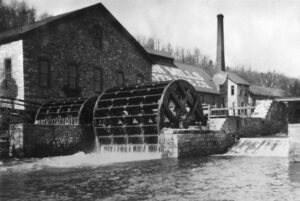
Even before the Delaware Canal was fully opened in 1832, those responsible for its construction realized that the water supplied by the Lehigh River in Easton was not enough to maintain a full Canal, particularly in the southern end. To solve this problem, an “ingenious device” was erected at the Union Mill (since converted into The Waterworks, a residential condominium complex) in New Hope.
In June of 1831, the Commonwealth of Pennsylvania contracted with Lewis S. Coryell and three of his business partners to erect a wing dam at Well’s Falls in the Delaware River and water wheels. The purpose of the dam was to supply water to a two-wheel system. There was an undershot water wheel driven by the power of the river flow, which was coupled with another wheel with buckets that scooped river water, raised it, and then allowed it to flow through a trunk leading to the Canal.
A traveler to New Hope in 1832 wrote, “This simple contrivance, without gearing or valves, or anything else liable to get out of order is more than sufficient to supply the Canal from New Hope downwards.” The waterwheels were capable of raising 3,500 cubic feet of water per minute. Although not as repair-free as the New Hope visitor envisioned, they remained in place until June of 1923 and then were carried away in a flood in 1936.
After 1923, the issue of insufficient water flowing southward reemerged, particularly when the level of the Delaware River dropped below the level of the New Hope inlet. Various remedies were tried, but none worked well enough.
As you have read in past issues of Canal News, the Friends, in partnership with the Delaware Canal State Park, are working to install a centrifugal pump in the River in the northern section of Washington Crossing Park. The pump and the electrical installation, financed by the Friends, are ready to go. The pipe leading from the River to the Canal is in place. Before putting the pump in operation, there is one approval that must be granted from the Pennsylvania Fish and Boat Commission.
The new “Bowman’s Hill” pump will augment the flow of water to Bristol as the New Hope waterwheels once did.
*****************************************************************************************
Lars Ahlman
Eric Beckhusen
Chris Cascone
Anna Christensen and Todd Borneman
Barbara and Jeff Clarke
Marc Engelsman
Terri and Jon Epstein
Heidi Furman
Dan Frank and Family
Harry Gamble
Melanie Gray and David Rubin
Edward Green
Nancy Hamill
Roxane and Bill Hansen
Jim Heim
Norma and Jeff Heller
Jill Henry
Jean Hewens
Kathleen Kennerley
Tom Kuhn
Jill Laurinaitis
Cathy Ann Leonard
Anthony Mannarino
Claire and Jerry Melican
Zoe Morawski
Anne and David Pearl
Francoise Picaronny
Tara Rivas
Jill and Howard Savin
Tony Tran
Kathrin Wagner
Paul West
Kari Williams
Alexander Witko
When the Commonwealth of Pennsylvania dug the 58.9-mile-long Delaware Canal between 1827 and 1831, it was responsible for connecting the private properties that the new ditch divided. Thus, more than 100 bridges were built, most of which were camelback bridges. A camelback bridge is a modified Queen Post Truss bridge, perfectly adapted for canal use since it has a hump in the middle, which allowed canal boats to more easily pass underneath.
Today the successors to the original camelback bridges are the Delaware Canal’s signature structures exemplifying the waterway’s history. Over the years, changes in vehicle types and traffic requirements have caused most of the bridge to be replaced with larger, hefty versions, but six authentic camelbacks still remain.
For over a decade, the Friends have been on a quest to ensure that these last six genuine pieces of history are restored. Not only are they vital factors to the Canal’s National Historic Landmark status, but their delicate design guides new construction. The Friends are directly responsible for the successful restoration of three of the camelbacks and were instrumental in the preservation of the fourth. Our volunteers perform continuing maintenance, such as painting and vegetation removal.
Two camelbacks are still in need of work – Woody’s Bridge south of Easton and Spahr’s Bridge in Bridgeton Township. This fall, the stars aligned in favor of Woody’s. It needed significant repairs so that it could continue to carry pedestrians, but was not so deteriorated that it needed a complete rebuild.
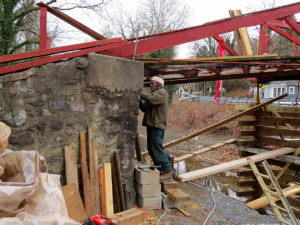
The Friends have partnered with the Delaware Canal State Park to get the job done now while the water is out of the Canal for other maintenance projects. Fundraising to cover the $31,800 labor cost is underway, and the Park has committed to pay for the materials. In the spirit of getting the job done this winter, Randy Myer of R-Shell Exteriors, Lancaster, PA is already at work. (Randy is a seasoned camelback restoration contractor having already completed the work on the Hazzard’s, Thompson-Neely, and Goat Farm bridges.)
So far, the Friends have raised $20,000 for this project thanks to generous contributors who want the Canal’s history preserved. Now we need your help to raise the balance of the needed funds. You may contribute on-line at www.fodc.org or send a check to Friends of the Delaware Canal, 145 South Main Street, New Hope, PA.
Please help restore Woody’s Bridge, the best example of how camelback bridges once were – delicate, graceful, utilitarian, and very beautiful.
****
The Friends’ Canal Action Team (CAT) has been tackling a wide variety of projects since it was formed in the winter of 2014. Everything from removing vegetation from stone walls to bridge painting to replacing interpretive signs to pulling out cattails is fair game.
As 2017 begins, we would like to reinvigorate our list of volunteers who are interested in working on the CAT.
WHO: Anyone who wants to and can be physically active. Especially needed are people who like to paint bridges and those who would like to lead a crew.
When: CAT projects can be undertaken both on weekdays and weekends. Usually they take no longer than 3-4 hours.
Where: Work sites are determined by the urgency of the job and the location and number of available volunteers.
The Plan: If you want to be part of CAT, please call 215-862-2021 or e-mail friends@fodc.org and give us your contact info and your preferred work locations (north, central, south). When a work day is developed, an e-mail notice containing the job details is sent to all the prospective volunteers about two weeks prior. Those who can help on a particular project just respond to the e-mail and show up on the appointed day.
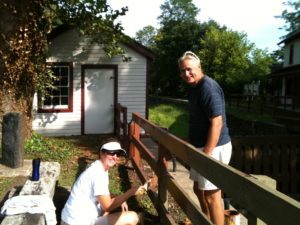
Be part of CAT! Get things done along the Canal and enjoy working with your fellow Friends.
****
My first seven months at the Canal have been exciting and full of challenges and successes. We wrapped up 2016 with several wall repair projects. During the maintenance drawdown in October we hired several contractors to make repairs to multiple walls that failed and collapsed along the Canal. Wall repairs have been completed at Lock 5 in Yardley, along Mile Post 21 in the Bowman’s Hill area, adjacent to Lock 22/23 in the Teddy Roosevelt Recreation Area, and at Woody’s Bridge in the Raubsville area. Also during the drawdown, Park and engineering staff were able to inspect several areas of the Canal and develop plans for future projects and maintenance work. Park maintenance crews were also busy repointing walls and waste gates, dredging, fixing additional sink holes ,and working on many other preventative maintenance projects. To close out 2016, the river/weather finally cooperated with us by providing enough rain and higher river levels to start re-watering the southern end of the canal during the middle of December.
2017 will bring its challenges and successes as well. We will be starting the New Year with several projects already in progress. First, in partnership with the Friends, an experienced contractor has been hired to make repairs to Woody’s Bridge in the Raubsville area. We have had another wall collapse in the Kintnersville area by Lehnenberg Road. A contractor has already been mobilized, and repairs to this wall have begun. Finally, the Park has discovered two new sinkholes in the northern section of the Park – one in Smithtown between Bridges 2 and 3 and the second in Williams Township just north of the Easton sewage treatment plant. Repairs to these sinkholes will be forthcoming once the weather decides to cooperate with us.
Also, work on the Lower Limeport Bridge in Solebury Township has begun and is expected to continue through April. We have another bridge project on the horizon as well. The final design work and permitting is being done for the Phillips’ Mill Bridge. We are expecting this project to go out to bid late this winter and to be ready for construction later this spring. Enjoy the Canal!
****
Our members just kept coming through the doors of the David Library of the American Revolution on November 15. The Rose Gallery, where the covered dish dinner was held, was filled with people and great food; and everyone was thankful for the spacious seating and high quality audio visual equipment upstairs in Stone Hall where our presentations were held. We are so appreciative of the Library’s willingness to share their facilities with the Friends.
We were pleased to have a wonderful turnout from the PA Department of Conservation and Natural Resources. With us were:
John Hallas, Director of the Bureau of State Parks, who gave a summary of DCNR’s accomplishments and plans
Jason Zimmerman, Manager of Park Region 4
Josh Swartley, Delaware Canal State Park Manager
Bethany Hare, Delaware Canal State Park Assistant Manager
Gene Gelfand, Engineer with DCNR’s Bureau of Facility Design and Construction, who was honored for his dedication to the preservation and improvement of the Canal and its historic structures, particularly its camelback bridges
David Kemmerer, retired Director of the Bureau of State Parks
The after-dinner presentation included some Friends’ Board of Directors business. Retiring Board member Stephanie Garomon was thanked for all her efforts on behalf of our organization, especially in terms of organizing fundraising events. Pam Can, Judy Franlin, Joan Fullerton, Lynn Vogel, and David Scheaffer were all elected to additional Board terms.
The Annual Meeting is always a great time to get together with old and new friends, take stock of the year’s activities, and gear up for the coming year. And that’s just what we did.
__________________________________________
At its January meeting, the Friends’ Board of Directors elected its officers for 2017. Serving will be:
Brett Webber – President
Pam Can – Vice-President
Lynn Vogel – Secretary
Peter Sperry – Treasurer
As always, the Board welcomes your participation and input.
****
Movies taken of the Delaware Canal during the first half of the 20th century and interviews with men and women who worked on the Canal are now available for you to see and hear on your computer, iPad, or phone. These treasures are easily accessible thanks to the efforts of the Solebury Township Historical Society and the cooperation of the National Canal Museum in Easton.
Two members of the Society, who are also dedicated members of the Friends of the Delaware Canal, collaborated with the National Canal Museum to preserve the Museum’s cassette and film collection. Robert McEwan, Society Vice President and archivist, and Elizabeth Carrick, the Society’s web consultant have devoted a tremendous number of hours to evaluating the collection and publishing the best of it on the Solebury Township Historical Society website www.soleburyhistory.org.
To share these valuable pieces of history with more canallers, the Society has very generously invited the Friends to place a link to the material on our website www.fodc.org. The movies and the interviews can be found here.
So, if you’ve wondered what the Delaware Canal was like when mule teams pulled coal-laden boats to market, you can now find out by just clicking.
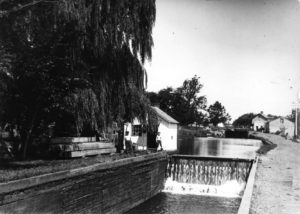
Save
What a summer! It’s been hot, hot, hot, but that hasn’t stopped the action along the Delaware Canal.
Hurricane Hermine did not wreak any havoc.
After the discovery of numerous sinkholes in Smithtown and Point Pleasant, areas notorious for leaks, DCNR quickly engaged Bi-State Construction to fill them with clay and regrade the towpath bank. With these sinkholes repaired, it is hoped that the Lehigh River water coming from the north will flow further south than it has since the Kleinhans Aqueduct problem.
No more walking on the shoulder next to whizzing cars thanks to PennDOT’s Route 13 improvement project. Park visitors now can use a sidewalk to get from the towpath to the Green Lane intersection in Bristol Township. Still to come is a pedestrian crossing south of WaWa on Green Lane with pavement markings and flashing signals. This project is being facilitated by the Pennsylvania Environmental Council.
After thorough investigations by DCNR staff, Sanders Power Company, and Campbell Electric, it has been determined that the 6,000 gallon per minute centrifugal pump that the friends purchased in 2003, before the floods, can be installed in the Delaware River at the northern “Bowman’s Hill” section of Washington Crossing Park. This pump can augment the flow in the watered-starved Canal when the River drops below the level of the New Hope inlet. Approval to operate the pump must be secured from the Delaware River Basin Commission.
By relieving DCNR of the purchase of the new pump at Centre Bridge, the Friends have enabled the Park to undertake the following wall projects: the repair of the concrete wall on the east side of Lock 5 in Yardley, the repair of the stone wing wall on the southwest end of Lock 5, the repair of the stone retaining wall north of Locks 22-23 by the Locktender’s House at the Theodore Roosevelt recreation Area in Raubsville, and the repair of the stone retaining wall along the towpath underneath Woody’s Bridge in Williams Township. Woody’s Bridge is one of the remaining six authentic camelbacks. By investing $27,000 in the Centre Bridge pump when the Park most needed it, the Friends have leveraged a $44,000 expenditure in wall repairs by DCNR.
The hope of having water diverted from the Point Pleasant Pumping Station into the Canal has been dashed, at least temporarily, because of the continuing drought and the well contamination problems in Bucks and Montgomery Counties. The Forest Park Water Authority must retain water for its customers.
The water levels in the Canal from New Hope south to Bristol range from very low to bone dry. The heat waves and drought have dropped the level of the Delaware River below the level of the New Hope inlet located behind Odette’s. When the gauge measuring the river level at Trenton, NJ reads less than 9 feet, there is no water entering the Canal. Water levels can be checked online at water.weather.gov – National Weather Service Advanced Hydrologic Prediction Service. After all that Hermine forecasting hype, it would have been nice to have a moderate amount of rain.
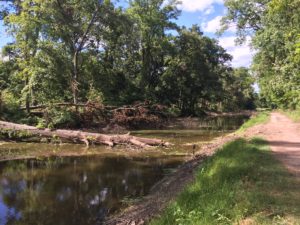
In July, tornado-like winds ripped through the Bowman’s Hill area. Enormous trees fell – more than a few of them into the Canal. DCNR brought in crews from other parks to deal with the immediate damage, but there is still much cutting and removal to do. Falling trees have plagued the Canal ever since Hurricane Sandy. It seems that a tree clearing contingent might need to be added to the Park maintenance staff or perhaps some assistance from the private sector.
As always, the Friends endeavor to meet the Canal’s challenges – in a multitude of ways.
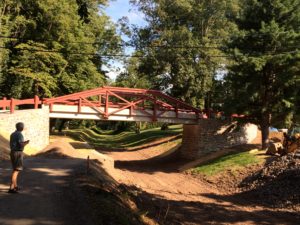
The reconstruction of the Redfield Bridge by Bi-State Construction is nearly complete. It crosses the Canal just north of Centre Bridge. Towpath users are ecstatic to be able to travel their PA/NJ Loop Trail again, and the Friends are tremendously pleased to have the reconstruction reflect the years of incremental work that has gone into creating a bridge design that conveys the Canal’s historic character while accommodating 21st century needs.
Bridges have always been of special interest to the Friends. Our organization has restored three of the six remaining authentic camelback bridges. The fourth was restored through the Save America’s Treasures program. At our urging, the DCNR engineers prepared a detailed guidebook for the repair of all six.
Nearly twenty years ago, after seeing each new Canal bridge have a different look, the Friends collaborated with the firm of Simone, Jaffe, Collins on the production of prototype bridge designs that could accommodate different traffic carrying capacities. The basic prototypes influenced PennDOT’s design decisions for five canal-spanning bridges and counting. As each bridge was built, the basic design was evaluated and improvements incorporated into the plans for the next.
Over the past several years, DCNR has been replacing the Canal bridges that it owns and maintains. Generally, the bridges provide required access to private property, either connecting the property to public roadways or other parts of the property itself. Once again design became an issue. The “commonly understood” faux camelback truss and guiderail designs to be used for the new bridges proved not to be so understood. The construction of the bulky Upper Limeport Bridge was a turning point. After the Friends cried “foul,” DCNR agreed to reconsider its design process, especially since several more bridge replacement projects – Redfield, Lower Limeport, and Phillips’ Mill – were in the pipeline. DCNR hired the Wilson Consulting Group of Mechanicsburg, PA to undertake the development of a different, more historically and contextually correct bridge design. Bill Wilson, principal of the firm, undertook the task with tenacity and enthusiasm consulting with the Pennsylvania Historical and Museum Commission and the Friends.
One of the key goals of the new design was to have Delaware Canal bridges reflect the delicacy of the original camelbacks while meeting current day requirements. New materials, technology and creativity have allowed that goal to be met. The Redfield Bridge is the first bridge to fully utilize the new design standards, and, although there are still some small wrinkles to be ironed out, Redfield Bridge is, by far, the best yet. The Bi-State Construction masons did a particularly fine job with the stone masonry.
DCNR continues with its bridge replacement projects with the Lower Limeport Bridge next up. Bi-state Construction has won the bid, and installation of the coffer dams and pipes to allow water to flow in the Canal is expected to get underway in late fall or early winter. May this bridge be even better.
We have been working on several projects over the summer and have recently competed some emergency sinkhole repairs. In the beginning of August, after a heavy rain storm, the Park maintenance crew discovered several large sinkholes between Bridges 2 and 3 to the Smithtown section of the Park. Upon closer inspection it was determined that there were more than a dozen sinkholes, with additional holes in the Mountainside Inn section of the Park. Over the course of three weeks Park maintenance staff and contractors were able to excavate the sinkholes, line them with bentomat, pack them with clay, cover them with topsoil, and reseed the berm of the canal. Repairs were completed the last week of August and the canal has been re-watered.
The Redfield Bridge project is coming to an end. The finishing touches are being made to the towpath, some minor adjustments being made to the trusses, and some clean up and restoration work being completed at the work site. Final inspection of the project should be forthcoming.
There are also two upcoming projects where the bids have been awarded. The Mile Post 21 wall repair project and the Lower Limeport Bridge replacement should be starting within the next few months.
Finally, there will be a maintenance draw down of the Canal during the last week of September. Due to regulations regarding the endangered red-bellied turtle, all de-watering activities must occur prior to October 1st. The draw down will enable the Park to work on several small wall repair projects, to conduct inspections of the canal prism, and to perform preventative maintenance.
Enjoy the Canal!
The growing season is drawing to a close at the Locktender’s House garden in New Hope. Goldfinches and squirrels are squabbling over the sunflowers, and there are enough tomatoes to share with passersby.
When the Friends restored the Locktender’s House in 1993-94, the grand plan included not only the creation of the “Life at the Lock” exhibit inside, but also the creation of a period vegetable and flower garden in front. Since locktenders and their families typically had gardens for their own use and to grow produce that could be sold to canal boat crews, the establishment of a garden seemed a natural. Friends’ volunteers transformed a grass patch into a fine plot surrounded by a white wooden picket fence typical of the period. It has become part of the overall story of “Life at the Lock” and delights visitors who enjoy its beauty and engage the volunteer gardeners in conversation.
Over the years, the white picket fence took beatings from both nature and vandals. Repairs were routinely made, but by last year, it was clear that it was time for a new fence. To the rescue came the Dames of Rocksville Questers, who after hearing about the garden at a Friends’ presentation, selected the fence project as the recipient of their annual preservation grant. In April, members of the group arrived at the Locktender’s House with a $900 check. The funds were promptly spent on fencing materials, and member Josh Gradwohl started to construct the fence from scratch. No premade sections for Josh. New posts were installed, and volunteers spent a morning staining the pickets. Josh and Jerry Taylor then proceeded to make a fence materialize, just in time for the grapevines to call it home.
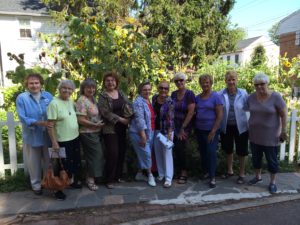
The Friends are very grateful to the Dames of Rocksville Questers for making the fence replacement possible. Half of the $900 grant was provided by the Dames chapter and was matched by the State Quester organization. The Dames of Rocksville Questers originated in Holland, PA and now includes more than 15 members from the Lower Bucks County area. Questers is a non-profit organization which encourages an appreciation for antiques and the preservation and restoration of historic sites.
Our talented and willing volunteers took the contributed materials and transformed them into a handsome, strong fence, and we are very appreciative.
Blankets of green appeared on the Canal’s water surface this summer. This green isn’t new, it starts to appear every year around May. Its bright chartreuse hue and abundant growth make it hard to miss.
But what is it?? It’s not algae or slime or an invasive. It’s duckweed – a plant that has many good qualities.
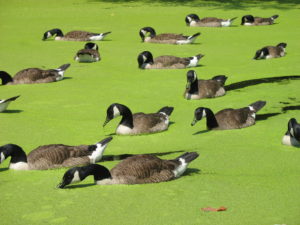
Lesser Duckweed (Lemna minor) is one of the smallest flowering plants in the world. It consists of just two leaves and a root. Duckweed likes to grow in warm, slow-moving, nutrient rich freshwater environments, which makes the Delaware Canal an ideal habitat for this tiny plant.
What is duckweed good for?
Food: Duckweed contains twice the protein, fat, and nitrogen and phosphorus of other similar plants. Its high nutritional content makes it an excellent source of food for waterfowl and fish. (Carp are particularly fond of it.) It is a primary food source for migrating waterfowl.
Shade: A mat of duckweed shades the water below, inhibiting the growth of algae and other plants that can choke nutrient-rich waterways.
Cleansing: Duckweed can help lower water pollution levels by absorbing nitrates, phosphates, and ammonia, which are chemicals found in fertilizers and waste water. It is often used as a biological treatment for waste water from large-scale commercial farms.
Reuse: After it is easily skimmed from the water, duckweed can be fed to animals and poultry and used as compost or fertilizer.
In the height of summer, duckweed can obscure the scenic value of the Canal, but is has its benefits and is far better for the environment than algae and invasive plants. And if you want a great addition to your compost pile, feel free to skim some off and take it home.
Thanks to Ian Kindle, Delaware Canal State Park Educator, for providing this information and photo.
If you are planning to use Amazon for holiday shopping this year, please remember that the Friends of the Delaware Canal is eligible to receive contributions from the AmazonSmile Foundation. Designate the Friends when you make a purchase from Amazon, and the Friends will receive a contribution.
Here’s how it works. Visit AmazonSmile on the internet, and choose Friends of the Delaware Canal as your charitable organization. For eligible purchases, the AmazonSmile Foundation will donate 0.5% of the purchase price to the Friends. It’s a quick and easy way to spread holliday cheer not only to the peo0ple on your gift list, but to the Friends, too.
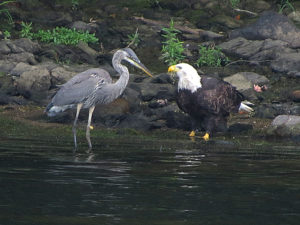
Nearly 450,000 people have seen this photo of a bald eagle and a great blue heron on the Friends of the Delaware Canal Facebook page. When all the views are in, we may even reach a half million!
Carole Mebus, Friends’ member and photographer extraordinaire, shares her photos with the Friends, and we post them on Facebook. In case, you weren’t among the many who saw the post, here’s the story of her amazing encounter.
On September 3, Carole embarked on a neighborly bird identification mission, but she never got to there because something caught her eye. “Across the River at the northern end of Canal Road in Raubsville was a fascinating sight. I took 96 pictures of a great blue heron and a bald eagle sharing a meal. When I first came on the scene, the eagle was eating the fish and the heron was looking on. They changed positions often from the log to the ground. It seemed like a sizable fish, and eventually the heron had some of it. Two crows even showed up briefly. How do I see things like this? I’m always looking around. And I am really lucky sometimes. It made my day.”
If you would like to see seven of the 96 photos, visit the Friends’ Facebook page, and while you’re there don’t forget to “Like” it. It’s hard to imagine that Carole won’t have more to share.
Three new Canal Tenders answered the call for help in the summer issue of Canal News. Thank you! Jim and Katie Wolf have adopted the Bridge Street to Lock 9 section of the Canal in New Hope. Harry Dozer will be providing weekend assistance to Peter Shaw in taking care of the Bridge 3 to Bridge 2 stretch in Smithtown.
Only 5.4 miles of the Canal are still orphans. Wouldn’t you like to adopt one? Find out how by going to www.fodc.org and clicking on HELP on the navigation bar.
Alan Bader
Janice Burgh
Neysa Garrett
Peggy and Mike Probst
Jeffrey Revak
Scannapieco Development Corporation
David Seidman
Greg Silk
Mitchell Zuckerman
Save
Save
Save
Save
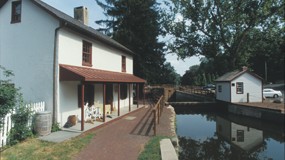
Friends of the Delaware Canal
145 South Main Street
New Hope, PA 18938
Phone: 215.862.2021
Michael Ginder, Executive Director
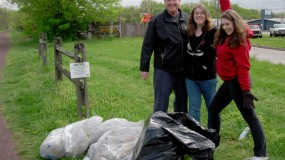
Helping on Canal Clean-up Day is just one way you can get involved and help to restore, preserve and improve the Delaware Canal. Big or small, the perfect job for you awaits – all you need to do is get involved! FIND OUT MORE